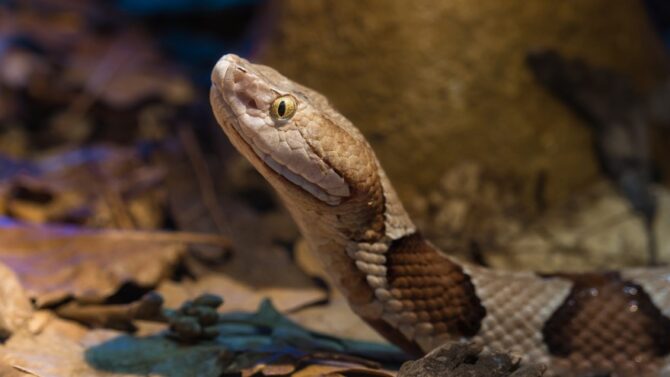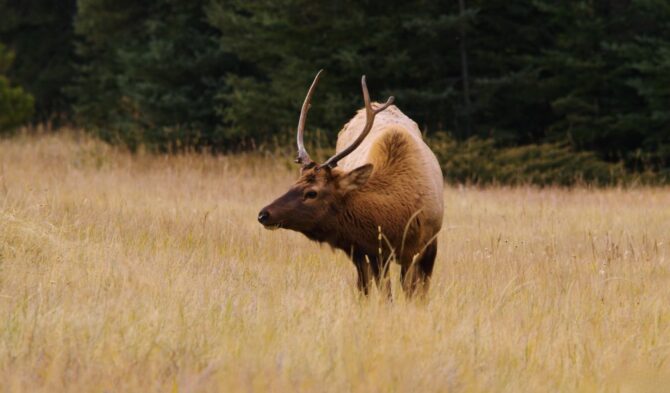South Carolina is ideal for many animals due to the natural habitats found within.
Here, you’d see forests, swamps, coastal shores, and a host of others.
Little wonder the state provides a good environment for 38 different snake species. Only 6 species are poisonous, and they are our focus.
Venomous snakes in South Carolina are the copperhead, Eastern diamondback rattlesnake, Eastern coral snake, cottonmouth, timber rattlesnake, and pygmy rattlesnake.
Let’s explore each of these poisonous snake species in detail.
The Venomous Snakes in South Carolina
1. Eastern Copperhead (Agkistrodon contortrix)
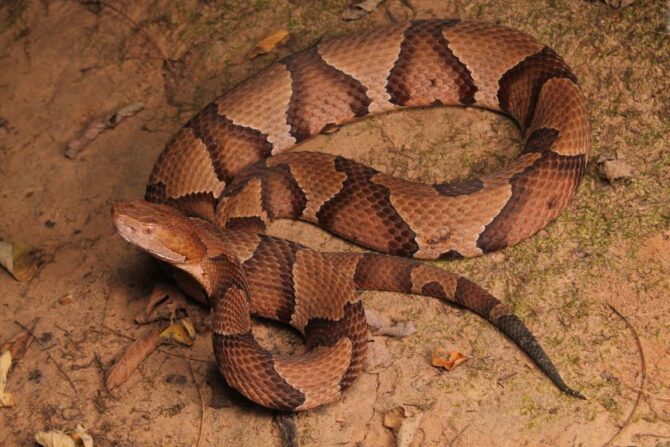
- Size: 20 to 37 inches
- Habitat: Deciduous forests, mixed woodlands, swamps, rock outcroppings
- Identifying Features: Broad head, pale tan color, patterns like an hourglass
- Behavior: Nocturnal, lying still
- Threats: Painful bites
The eastern copperhead is one of the most common venomous snakes in the United States.
It also lives in South Carolina. Its favorite spots in most parts of the United States are deciduous forests and mixed woodlands.
It can also stay in some swampy areas and rock outcroppings. This snake can simply be called a copperhead.
The eastern copperhead is easily recognized by its tan color and patterns like an hourglass. It Is impressive and also venomous.
The copperhead’s bite is painful, and the venom leads to other symptoms like nausea, swelling, and throbbing.
Its bite is rarely fatal, and the eastern copperhead is not as dangerous as many other venomous snakes. That said, exercise caution.
2. Cottonmouth (Agkistrodon piscivorus)

- Size: 26 to 35 inches
- Habitat: Creeks, streams, marshes, swamps, lakes
- Identifying Features: Broad head, black skin, patterns
- Behavior: Opening mouth, shaking tail, both diurnal and nocturnal
- Threats: Cytotoxin, venom yield 125mg, swelling, pain
The cottonmouth is a semi-aquatic snake that lives close to creeks, streams, lakes, and others.
It is native to the United States, specifically the southeastern parts.
The copperhead and the cottonmouth are both very common venomous snakes in South Carolina.
Its main name is due to the way it opens its mouth when threatened, exposing the white within. It might also bare its fangs or coil.
The cottonmouth’s venom is not always fatal, but it can be painful and toxic.
Without treatment, the victim can die. The cytotoxin in the venom destroys tissues, and sometimes it can lead to the amputation of the affected organ. The bite also causes swelling.
3. Timber Rattlesnake (Crotalus horridus)
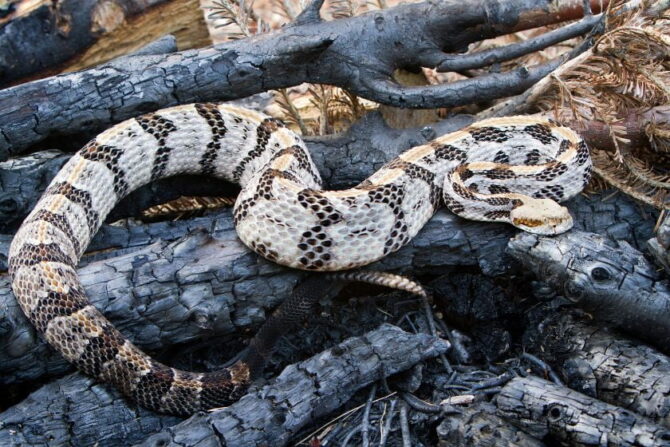
- Size: 36 to 60 inches
- Habitat: Deciduous forests, mountains, coastal plains
- Identifying Features: Gray color, black, yellow, stripes on the back, pinkish hue
- Behavior: Docile, solitary
- Threats: Hemotoxin, neurotoxin
The timber rattlesnake is also known as the canebrake rattlesnake and the banded rattlesnake.
In South Carolina, it goes by two names, the timber rattlesnake and the canebrake rattlesnake. This depends on the location.
Individuals in the mountains are called timber rattlesnakes, while those on the coastal plains are termed the canebrake.
There are color differences between both variants, but they are the same species.
The timber rattlesnake is a dangerous snake in South Carolina.
Its venom contains both hemotoxin and neurotoxin, which leaves the victim in a bad state.
It doesn’t attack snakes preemptively but will strike back if accidentally stepped on.
4. Pygmy Rattlesnake (Sistrurus miliarius)
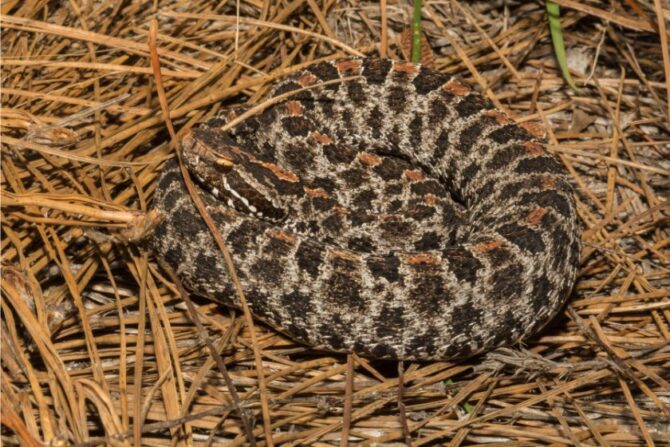
- Size: 16 to 24 inches
- Habitat: Flatwoods, mixed forests, floodplains, lakes, marshes
- Identifying Features: Dorsal patterns, slim tail with a rattle, diurnal
- Behavior: Nocturnal, solitary,
- Threats: Cytotoxin, painful bite.
The pygmy rattlesnake is a small, venomous animal that stays in South Carolina and is widespread in the state.
It can also be found in some other parts of the United States. It inhabits a variety of habitats, including flatwoods, forests, and lakes.
Like other rattlesnakes, this creature has a rattle at its tail that it shakes when it wants to scare off predators.
While the pygmy’s size makes its venom less fatal to humans, this snake should be regarded as dangerous.
The cytotoxin in its venom damages tissues. Because it is small, you might not hear it shaking the rattle. Accidental bites are very common.
5. Eastern Coral Snake (Micrurus fulvius)

- Size: 31 inches
- Habitat: Glade land, high pine, scrub oak
- Identifying Features: Small, dorsal scales, black head
- Behavior: Solitary, not aggressive, terrestrial
- Threats: Neurotoxin, paralysis, respiration problems, double vision
The eastern coral snake can be simply called the coral snake. It is endemic to the United States and occurs in the Southeast.
Due to its solitary nature, it is rarely found in South Carolina. It is similar to two non-venomous snakes, the scarlet snake and the scarlet kingsnake.
The eastern coral snake is lovely to see, with a combination of black, yellow, and red patterns.
The chances of getting bit by the eastern coral snake are low but not impossible.
This animal is highly venomous, containing a very potent neurotoxin. Deaths from the eastern coral snake are rare, but there are other symptoms to look out for.
This includes slurred speech, paralysis, and double vision. In extreme cases, it can lead to respiratory failure.
6. Eastern Diamondback Rattlesnake (Crotalus adamanteus)
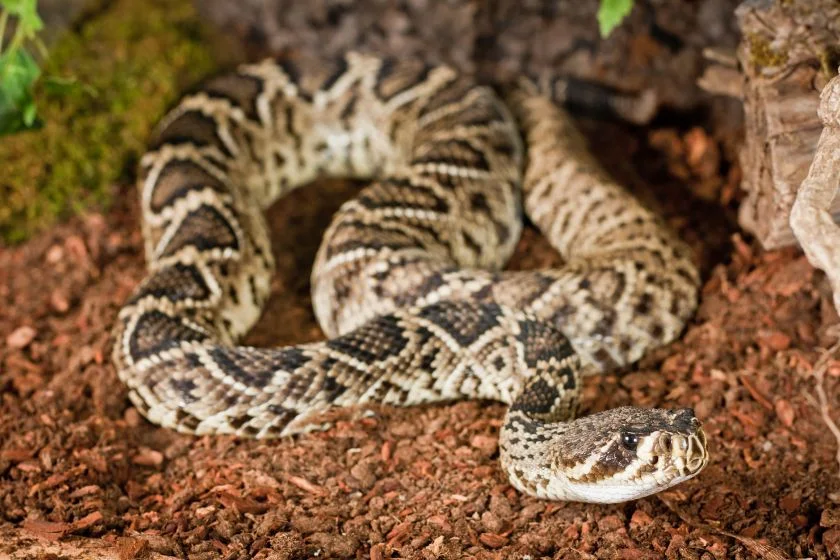
- Size: 7.8 feet
- Habitat: Dry pine forests, sandhills, coastal maritime hammocks, salt marshes
- Identifying Features: Large head, bulky, blackish brown, olive or dusty gray color, patterns
- Behavior: Cold-blooded, solitary
- Threats: Long fangs, 400-450 mg venom, crotalase
The eastern diamondback rattlesnake is the largest rattlesnake and the largest venomous snake in the Americas.
These facts alone are enough to conclude that the diamondback is a dangerous species.
This snake is endemic to the United States, though it’s not very common in South Carolina.
The eastern diamondback rattlesnake has potent venom, and its size adds up to make it deadly.
The snake itself is a solitary animal and hardly attacks except provoked. Like other rattlesnakes, it shakes the rattle when someone approaches.
You should step away once you hear such. Symptoms of this rattlesnake bite include intense pain, bleeding, and swelling.
Final Thoughts
If you love exploring snakes, you should check out South Carolina.
Just be careful of the six poisonous snakes in South Carolina. While not always aggressive, these animals can land someone in a bad place with their venom.
Take extra precautions when exploring the habitats these deadly snakes might be living in.
Next Up
- 10 Most Venomous Snakes In The World
- 10 Most Dangerous Animals In South Carolina (Watch Out)
- Venomous vs. Non-Venomous Snakes: What are the Glaring Differences
